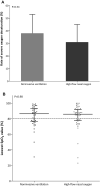Noninvasive ventilation vs. high-flow nasal cannula oxygen for preoxygenation before intubation in patients with obesity: a post hoc analysis of a randomized controlled trial
- PMID: 34292408
- PMCID: PMC8295638
- DOI: 10.1186/s13613-021-00892-8
Noninvasive ventilation vs. high-flow nasal cannula oxygen for preoxygenation before intubation in patients with obesity: a post hoc analysis of a randomized controlled trial
Abstract
Background: Critically ill patients with obesity may have an increased risk of difficult intubation and subsequent severe hypoxemia. We hypothesized that pre-oxygenation with noninvasive ventilation before intubation as compared with high-flow nasal cannula oxygen may decrease the risk of severe hypoxemia in patients with obesity.
Methods: Post hoc subgroup analysis of critically ill patients with obesity (body mass index ≥ 30 kg·m-2) from a multicenter randomized controlled trial comparing preoxygenation with noninvasive ventilation and high-flow nasal oxygen before intubation of patients with acute hypoxemic respiratory failure (PaO2/FiO2 < 300 mm Hg). The primary outcome was the occurrence of severe hypoxemia (pulse oximetry < 80%) during the intubation procedure.
Results: Among the 313 patients included in the original trial, 91 (29%) had obesity with a mean body mass index of 35 ± 5 kg·m-2. Patients with obesity were more likely to experience an episode of severe hypoxemia during intubation procedure than patients without obesity: 34% (31/91) vs. 22% (49/222); difference, 12%; 95% CI 1 to 23%; P = 0.03. Among patients with obesity, 40 received preoxygenation with noninvasive ventilation and 51 with high-flow nasal oxygen. Severe hypoxemia occurred in 15 patients (37%) with noninvasive ventilation and 16 patients (31%) with high-flow nasal oxygen (difference, 6%; 95% CI - 13 to 25%; P = 0.54). The lowest pulse oximetry values during intubation procedure were 87% [interquartile range, 77-93] with noninvasive ventilation and 86% [78-92] with high-flow nasal oxygen (P = 0.98). After multivariable analysis, factors independently associated with severe hypoxemia in patients with obesity were intubation difficulty scale > 5 points and respiratory primary failure as reason for admission.
Conclusions: Patients with obesity and acute hypoxemic respiratory failure had an increased risk of severe hypoxemia during intubation procedure as compared to patients without obesity. However, preoxygenation with noninvasive ventilation may not reduce this risk compared with high-flow nasal oxygen. Trial registration Clinical trial number: NCT02668458 ( http://www.clinicaltrials.gov ).
Keywords: High-flow oxygen; Hypoxemia; Intubation; Non-invasive ventilation; Obesity; Preoxygenation; Respiratory failure.
© 2021. The Author(s).
Conflict of interest statement
JPF reports grants, personal fees and non-financial support from the “Fisher & Paykel HealthCare” firm, during the conduct of the original study; personal fees and non-financial support from SOS oxygène, outside the submitted work.
AD reports personal fees from Medtronic, grants, personal fees and non-financial support from Philips, personal fees from Baxter, personal fees from Hamilton, personal fees and non-financial support from Fisher & Paykel, grants from French Ministry of Health, personal fees from Getinge, grants and personal fees from Respinor, grants and non-financial support from Lungpacer, outside the submitted work.
CG reports non-financial support and other from Fisher & Paykel Healthcare, during the conduct of the study; personal fees from Fisher & Paykel Healthcare, outside the submitted work.
JDR reports coverage by Fisher & Paykel Healthcare of expenses to attend scientific meetings.
RC reports non-financial support from MSD, outside the submitted work.
RR reports non-financial support from Fresenius Medical Care, from Baxter Gambro, outside the submitted work.
AWT reports personal fees and non-financial support from Fisher & Paykel.
SE reports personal consulting fees, speaker fees and research support from Aerogen Ltd and speaker fees and research support from Fisher & Paykel.
The other authors declared no conflicts of interest.
Figures


References
-
- WHO. WHO: Global obesity epidemiology. https://www.who.int/gho/ncd/risk_factors/overweight/en/. Accessed 29 Apr 2020.
-
- De Jong A, Molinari N, Pouzeratte Y, Verzilli D, Chanques G, Jung B, Futier E, Perrigault PF, Colson P, Capdevila X, et al. Difficult intubation in obese patients: incidence, risk factors, and complications in the operating theatre and in intensive care units. Br J Anaesth. 2015;114(2):297–306. doi: 10.1093/bja/aeu373. - DOI - PubMed
Associated data
Grants and funding
LinkOut - more resources
Full Text Sources
Medical

